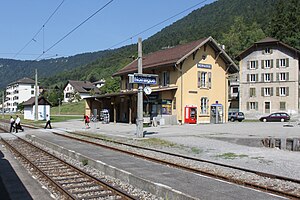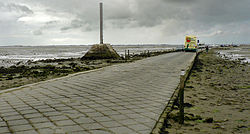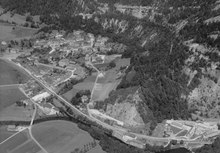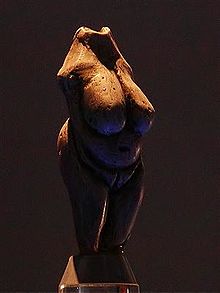Noirmoutier
 Noirmoutier Island image from satellite Spot | |
| Geography | |
|---|---|
| Location | Atlantic Ocean |
| Coordinates | 46°58′N 2°13′WCoordinates: 46°58′N 2°13′W |
| Area | 49 km2 (19 sq mi) |
| Length | 19 km (11.8 mi) |
| Width | 6 km (3.7 mi) |
| Highest elevation | 20 m (70 ft) |
| Highest point | No named |
| Administration | |
France | |
| Region | Pays de la Loire |
| Department | Vendée |
| Arrondissement | Les Sables-d'Olonne |
| Demographics | |
| Population | 9,590 |
| Pop. density | 195.76/km2 (507.02/sq mi) |
| Ethnic groups | French people |
| Official name | Marais Breton, Baie de Bourgneuf, Ile de Noirmoutier et Forêt de Monts |
| Designated | 2 February 2017 |
| Reference no. | 2283[1] |
Noirmoutier (also French: Île de Noirmoutier, pronounced [nwaʁmutje]; Breton: Nervouster, Nermouster) is a tidal island off the Atlantic coast of France in the Vendée department (85).
History
Noirmoutier was the location of an early Viking raid in 799, when raiders attacked the monastery of Saint Philibert of Jumièges in 799.[2]
The Vikings established a permanent base on the island around 824, from which they could control southeast Brittany by the 840s. In 848, they sacked Bordeaux. From 862 until 882, Hastein used it as a base from which he raided Francia and Brittany.[3]
On 4 July 1674, during the Franco-Dutch war, the island was briefly captured by Dutch forces under the command of Cornelis Tromp. The Dutch flag flew from the walls on the island for nearly three weeks until, on 23 July, the Dutch abandoned the it after blowing up the castle and demolishing the coastal batteries.
Noirmoutier was the site of several campaigns in the War of the Vendée, as well as a massacre [4] and the place of execution of the Royalist Generalissimo Maurice D'Elbée, who faced the firing squad seated in a chair due to wounds accumulated from an earlier battle.
St. Mary Euphrasia Pelletier was born on this island on 31 July 1796.
Geography
The island comprises ten localities and four distinct Communes of France. Its length is approximately 25 kilometres (16 mi), and its width varies from 500 metres (1,600 ft) to 15 kilometres (9.3 mi). Its area of 4,877 hectares (12,050 acres; 48.77 km2; 18.83 sq mi).
Noirmoutier is referred to as the Island of Mimosas, due to the temperateness of its climate, which allows for the flowering of Acacia dealbata (mimosa) year-round. The island is predominantly salt marsh and salt banks, sand dunes and evergreen oak forests.
The communes of the island are grouped into a communauté de communes. The communes are:
The island has been a site of uninterrupted human inhabitation since prehistoric times, and is a popular tourist destination.
Parts of the island have been reclaimed from the sea. In 2005 it served as the finish of the Tour de France prologue.
Transport
The island is most notable for the Passage du Gois, a paved-over sandbank with a length of 4.5 kilometres (2.8 mi),[5] one of the routes that connect the island to the mainland. It is flooded twice a day by the high tide. Until the early 1970s, a ferry service operated across the Strait of Fromentine between the La Fosse pier on the island and Fromentine pier on the mainland. This was superseded by the construction of the Noirmoutier Bridge, inaugurated in July 1971.
Events
Every year, an international foot race; the Foulées du Gois, is held across it, starting at the onset of the high tide.
La “Fête de la Bonnotte” (Bonnotte party) is also an annual festival celebrating the first day of potato harvest on the island of Noirmoutier.[6]
Infrastructure
In response to an effort by the French government to add offshore wind projects to the national grid, a 496 MW wind farm is being developed near the island, with a planned commissioning date of 2021.[7]
Climate
Noirmoutier experiences an oceanic climate typical of the west coast of France. Both the winters and summers are heavily moderated by the surrounding Atlantic Ocean. There is a low degree of diurnal temperature variation throughout the year, especially in the winter. There is considerably more precipitation in winter compared to summer.
| Climate data for Noirmoutier Island, Vendée | |||||||||||||
|---|---|---|---|---|---|---|---|---|---|---|---|---|---|
| Month | Jan | Feb | Mar | Apr | May | Jun | Jul | Aug | Sep | Oct | Nov | Dec | Year |
| Record high °C (°F) | 16.9 (62.4) |
17.5 (63.5) |
22.9 (73.2) |
27.5 (81.5) |
31.3 (88.3) |
36.0 (96.8) |
37.0 (98.6) |
37.0 (98.6) |
33.0 (91.4) |
27.1 (80.8) |
20.5 (68.9) |
16.1 (61.0) |
37.0 (98.6) |
| Average high °C (°F) | 9.3 (48.7) |
9.8 (49.6) |
12.5 (54.5) |
14.9 (58.8) |
18.4 (65.1) |
21.5 (70.7) |
23.4 (74.1) |
23.5 (74.3) |
21.4 (70.5) |
17.4 (63.3) |
12.9 (55.2) |
9.9 (49.8) |
16.2 (61.2) |
| Average low °C (°F) | 4.7 (40.5) |
4.5 (40.1) |
6.4 (43.5) |
8.0 (46.4) |
11.3 (52.3) |
13.9 (57.0) |
15.7 (60.3) |
15.8 (60.4) |
13.9 (57.0) |
11.5 (52.7) |
7.7 (45.9) |
5.2 (41.4) |
9.9 (49.8) |
| Record low °C (°F) | −10.0 (14.0) |
−7.7 (18.1) |
−6.0 (21.2) |
0.0 (32.0) |
0.5 (32.9) |
6.0 (42.8) |
10.4 (50.7) |
9.5 (49.1) |
7.0 (44.6) |
1.7 (35.1) |
−4.0 (24.8) |
−8.0 (17.6) |
−10.0 (14.0) |
| Average precipitation mm (inches) | 70.1 (2.76) |
56.6 (2.23) |
49.4 (1.94) |
52.1 (2.05) |
52.2 (2.06) |
34.2 (1.35) |
38.6 (1.52) |
31.5 (1.24) |
56.9 (2.24) |
85.2 (3.35) |
80.9 (3.19) |
78.4 (3.09) |
686.1 (27.02) |
| Average precipitation days | 12 | 10 | 10 | 10 | 9 | 7 | 6 | 6 | 9 | 12 | 12 | 13 | 116 |
| Mean monthly sunshine hours | 87 | 136 | 182 | 226 | 255 | 291 | 274 | 259 | 233 | 149 | 107 | 112 | 2,311 |
| Source: Météo France - Period 1981-2010 - Extremes since 1959. | |||||||||||||
References
- "496MW French Offshore Wind Farm Gets New Layout". Offshore Wind. 29 July 2016. Retrieved 1 August 2016.
External links
https://en.wikipedia.org/wiki/Noirmoutier
Noiraigue
Location of Noiraigue | |
| Coordinates: 46°57′N 6°43′ECoordinates: 46°57′N 6°43′E | |
| Country | Switzerland |
|---|---|
| Canton | Neuchâtel |
| District | Val-de-Travers |
| Area | |
| • Total | 6.38 km2 (2.46 sq mi) |
| Elevation | 729 m (2,392 ft) |
| Population (December 2007) | |
| • Total | 506 |
| • Density | 79/km2 (210/sq mi) |
| Time zone | UTC+01:00 (Central European Time) |
| • Summer (DST) | UTC+02:00 (Central European Summer Time) |
| Postal code(s) | 2103 |
| SFOS number | 6508 |
| Surrounded by | Boudry, Brot-Dessous, Brot-Plamboz, Gorgier, Travers |
| Website | SFSO statistics |
Noiraigue or Noiraigue-Les Œillons was a municipality in the district of Val-de-Travers in the canton of Neuchâtel in Switzerland. On 1 January 2009, the former municipalities of Boveresse, Buttes, Couvet, Fleurier, Les Bayards, Môtiers, Noiraigue, Saint-Sulpice and Travers merged to form Val-de-Travers.[1]
References
- Amtliches Gemeindeverzeichnis der Schweiz published by the Swiss Federal Statistical Office (in German) accessed 14 January 2010
https://en.wikipedia.org/wiki/Noiraigue
Noiraigue railway station
Noiraigue | |||||||||||
|---|---|---|---|---|---|---|---|---|---|---|---|
 The station in 2009 | |||||||||||
| General information | |||||||||||
| Location | Val-de-Travers Switzerland | ||||||||||
| Coordinates | 46°57′17.712″N 6°43′18.476″ECoordinates: 46°57′17.712″N 6°43′18.476″E | ||||||||||
| Owned by | Swiss Federal Railways | ||||||||||
| Line(s) | Neuchâtel–Pontarlier line | ||||||||||
| Distance | 18.1 km (11.2 mi) from Neuchâtel[1] | ||||||||||
| Train operators | Transports publics Neuchâtelois | ||||||||||
| Other information | |||||||||||
| Fare zone | 30 (Onde Verte)[2] | ||||||||||
| Passengers | |||||||||||
| 2018 | 310 per weekday[3] | ||||||||||
| Services | |||||||||||
| |||||||||||
| Location | |||||||||||
Noiraigue railway station (French: Gare de Noiraigue) is a railway station in the municipality of Val-de-Travers, in the Swiss canton of Neuchâtel. It is an intermediate stop on the standard gauge Neuchâtel–Pontarlier line of Swiss Federal Railways.[1]
Services
The following services stop at Noiraigue:[4]
References
- "Frasne/Buttes - Fleurier - Travers - Neuchâtel" (PDF) (in French). Bundesamt für Verkehr. 5 November 2019. Retrieved 26 July 2020.
External links
 Media related to Noiraigue railway station at Wikimedia Commons
Media related to Noiraigue railway station at Wikimedia Commons- Noiraigue railway station – SBB
https://en.wikipedia.org/wiki/Noiraigue_railway_station
Paleolithic Europe, or Old Stone Age Europe, encompasses the Paleolithic or Old Stone Age in Europe from the arrival of the first archaic humans, about 1.4 million years ago until the beginning of the Mesolithic (also Epipaleolithic) around 10,000 years ago. This period thus covers over 99% of the total human presence on the European continent.[1] The early arrival and disappearance of Homo erectus and Homo heidelbergensis, the appearance, complete evolution and eventual demise of Homo neanderthalensis and the immigration and successful settlement of Homo sapiens all have taken place during the European Paleolithic.[2]
Overview
The period is divided into:
- the Lower Paleolithic, from the earliest human presence (Homo antecessor and Homo heidelbergensis)[2] to the Holstein interglacial, c. 1.4 to 0.3 million years ago;
- the Middle Paleolithic, marked by the presence of Neanderthals, 300,000 to 40,000 years ago;[2]
- the Upper Paleolithic, c. 46,000 to 12,000 years ago, marked by the arrival of anatomically modern humans and extending throughout the Last Glacial Maximum;[3]
- the Mesolithic or Epipaleolithic, beginning about 14,000 years ago and extending until as late as 4,000 years ago in northern Europe. The Mesolithic may or may not be included as the final phase of the Upper Paleolithic.[2]
Paleolithic
Lower Paleolithic : 1.4 mya – 300,000 BP
The oldest evidence of human occupation in Eastern Europe comes from the Kozarnika cave in Bulgaria where a single human tooth and flint artifacts have been dated to at least 1.4 million years ago. In Western Europe at Atapuerca in Spain, human remains have been found that are from 1.2 million years ago.[5][6] Five Homo erectus skulls were discovered at an excavation site in Dmanisi, Georgia. Unearthed in 2005 and described in a publication in 2013, the Dmanisi skull 5 is estimated to be about 1.8 million years old.[7]
The earliest evidence for the use of the more advanced Mode 2-type assemblages Acheulean tools are 900,000 year-old flint hand axes found in Iberia and at a 700,000 year-old site in central France. Notable human fossils from this period were found in Kozarnika in Bulgaria (1.4 mya), at Atapuerca in Spain (1.2 mya), in Mauer in Germany (500k), at Eartham Pit, Boxgrove England (478k), at Swanscombe in England (400k), and Tautavel in France (400k).[8]
The oldest complete hunting weapons ever found anywhere in the world were discovered in 1995 in a coal mine near the town Schöningen, Germany, where the Schöningen spears, eight 380,000-year-old wooden javelins were unearthed.[9]
Middle Paleolithic : 300,000–50,000 BP
Elements of the European and African Homo erectus populations evolved between 800,000 and 400,000 years ago through a series of intermediate speciations towards Homo antecessor and Homo heidelbergensis.[10] Fossils of the species Homo neanderthalensis are only to be found in Eurasia.[11][12][13][14] Neanderthal fossil record ranges from Western Europe to the Altai Mountains in Central Asia and the Ural Mountains in the North to the Levant in the South. Unlike its predecessors they were biologically and culturally adapted to survival in cold environments and successfully extended their range to the glacial environments of central Europe and the Russian plains. The great number and in some cases exceptional state of preservation of Neanderthal fossils and cultural assemblages enables researchers to provide a detailed and accurate data on behavior and culture.[15][16] Neanderthals are associated with the Mousterian culture (Mode 3), stone tools that first appeared approximately 160,000 years ago.[17][18]
Experts debate over whether the "Divje Babe flute" from the Divje Babe I cave is evidence—based on if the object is an actual flute—that the Middle Paleolithic Neanderthal inhabitants of Europe may have made and used musical instruments.[19]
Upper Paleolithic : 50,000–10,000 BP
The earliest modern human which have been directly dated are from 46,000 to 44,000 years ago in the Bacho Kiro cave, located in present-day Bulgaria. They are associated with the Initial Upper Paleolithic (IUP), the earliest culture of modern humans in Europe.[20][21] These people do not appear to have been the ancestors of later Europeans as the very few ancient DNA (aDNA) samples recovered from this period are not related to later samples.[22]
Aurignacian
The IUP was followed by the Aurignacian. The origins of this culture can be located in Eastern Europe, in what is now Bulgaria (proto-Aurignacian) and Hungary (first full Aurignacian). By 35,000 BCE, the Aurignacian culture and its technology had extended through most of Europe.[23][24] Studies of aDNA have found an association between 35,000 year old Aurignacian remains in the Goyet Cave system in Belgium and Mesolithic hunter-gatherers in Western Europe. The same aDNA signature is found in the intervening period in Iberia, suggesting that the area was a refuge for hunter-gatherers at the height of the Last Glacial Maximum.[22]
Gravettian
Around 32,000 BCE, the Gravettian culture appears in the Crimean Mountains (southern Ukraine).[25][26] Around 22,000 BCE, the Solutrean and Gravettian cultures reach the southwestern region of Europe. The Gravettian technology/culture has been theorized to have come with migrations of people from the Middle East, Anatolia, and the Balkans. The cultures might be linked with the transitional cultures mentioned before, because their techniques have some similarities and are both very different from Aurignacian ones but this issue is thus far very obscure. The Gravettian soon disappears from southwestern Europe, with the notable exception of the Mediterranean coasts of Iberia. The Gravettian culture also appears in the Caucasus and the Zagros Mountains.
The Solutrean culture, extended from northern Spain to southeastern France, includes not only an advanced stone technology but also the first significant development of cave painting, the use of the needle and possibly that of the bow and arrow.
The more widespread Gravettian culture is no less advanced, at least in artistic terms: sculpture (mainly venuses) is the most outstanding form of creative expression of these peoples.[3]
Transition to the Mesolithic
Around 17,000 BCE, Europe witnesses the appearance of a new culture, known as Magdalenian, possibly rooted in the old Aurignacian one. This culture soon supersedes the Solutrean area and also the Gravettian of Central Europe. However, in Mediterranean Iberia, the Italian Peninsula, and Eastern Europe, epi-Gravettian cultures continue evolving locally.
With the Magdalenian culture, Paleolithic development in Europe reaches its peak and this is reflected in the advanced art, owing to the previous traditions of painting in the West and sculpture in Central Europe.[27]
Around 10,500 BCE, the Würm Glacial age ends. Slowly, through the following millennia, temperatures and sea levels rise, changing the environment of prehistoric people. Nevertheless, Magdalenian culture persists until circa 8000 BCE, when it quickly evolves into two microlithist cultures: Azilian, in northern Spain and southern France, and Sauveterrian, in northern France and Central Europe, which are described as either Epipaleolithic or Mesolithic. Though there are some differences, both cultures share several traits: the creation of very small stone tools called microliths and the scarcity of figurative art, which seems to have vanished almost completely, being replaced by abstract decoration of tools, and in the Azilian, pebbles.
In the late phase of this Epipaleolithic period, the Sauveterrian culture evolves into the so-called Tardenoisian and influences strongly its southern neighbour, clearly replacing it in Mediterranean Spain and Portugal. The recession of the glaciers allows human colonization in Northern Europe for the first time. The Maglemosian culture, derived from the Sauveterre-Tardenois culture but with a strong personality, colonizes Denmark and the nearby regions, including parts of Great Britain.[28][29][30]
See also
References
Neanderthals inhabited Eurasia from the Atlantic regions…
...The Mousterian stone tool industry of Neanderthals is characterized by…
One of the earliest dates for an Aurignacian assemblage is greater than 43,000 BP from Bacho Kiro cave in Bulgaria ...
- "Mesolithic Culture of Europe" (PDF). e-Acharya INFLIBNET. Retrieved 22 January 2019.
External links
Paleolithic sites in France:
- Culture.gouv.fr: Lascaux (in English)
- Culture.gouv.fr: Chauvet (in French)
https://en.wikipedia.org/wiki/Paleolithic_Europe
In Canada
- Noire River (Ottawa River tributary), in the Outaouais region of Quebec
- Noire River, a tributary of the Yamaska River in Eastern Townships area, Quebec
In France
- La Roche-Noire, a village and commune in the Puy-de-Dôme department
- Montagne Noire, a mountain range
In Guadeloupe
- Pointe-Noire, Guadeloupe, a commune on Guadeloupe
In the Republic of the Congo
- Pointe-Noire, second largest city in the Republic of the Congo
- Pointe Noire Airport, airport of Pointe-Noire
- Pointe-Noire Bay, bay at Pointe-Noire
People
Arts, entertainment, and media
Genres
- Film noir, a film genre
- Neo-noir, a modern form of film noir
- Horror noir, psychological horror and supernatural horror mystery in a noir film (List) or an occult detective ghost hunter film
- Tech-noir, technophiles and technology harming a society in a dystopian setting
- Folk noir, a music genre
- Noir fiction, a literary genre closely related to hardboiled genre
- Scandinavian noir, Scandinavian crime fiction
Comics
- Magie Noire, a 2003 comic by the Ivorian painter and author Gilbert G. Groud
- Marvel Noir, a 2009 thematic stories based on Marvel universe
- Noir: A Collection of Crime Comics, a 2009 black-and-white crime comics anthology
Fictional characters
- Noir, alias of Ray Balzac Courland in Gorgeous Carat manga
- Noir, a character in the video game La Pucelle: Tactics (2002)
- Noire, a character in the video game Fire Emblem: Awakening (2012)
- Noire, a character in the video game Hyperdimension Neptunia
- Cat Noir (Chat Noir in the French dub and Black Cat in the Korean dub), the superhero identity of protagonist Adrien Agreste in Miraculous: Tales of Ladybug & Cat Noir
- Guy Noir, a fictional private detective in A Prairie Home Companion radio show
- Jack Noir, a character in the webcomic Homestuck
- Madame Noir, a character in the Ressha Sentai ToQger
- Spider-Man Noir, a Marvel comic book character
- Vince Noir, a fictional character in the BBC television comedy The Mighty Boosh
- Noir (ノワール), the main antagonist in the anime series Kirakira PreCure a la Mode
- Noir Stardia, the main protagonist in the anime series The Hidden Dungeon Only I Can Enter
- Noir is the codename of Haru Okumura in the role-playing game Persona 5
- Black Noir, a character in the comic and TV series The Boys
Games
- Discworld Noir, a 1999 video game by GT Interactive
- L.A. Noire, a 2011 video game by Rockstar Games
- Noir: A Shadowy Thriller, a 1996 video game by Cyberdreams
- Trente et Quarante (English translation: Thirty and Forty), a gambling game also called Rouge et Noir (English translation: Red and Black)
Music
Groups and labels
- Noir (band), a South Korean boy band which debuted in 2018
- Noir, a poetic/techno music duo comprising Georg Kajanus and Tim Dry
Albums
- Noir (Callisto album), 2006
- Noir (William Control album), 2010
- Noir (BSBD album), 2011
- Noir (B.A.P album), 2016
- Noir (Smino album), 2018
Songs
- "Noir" (song), released by Sunmi in 2019
Other uses in music
- Noire, in musical instructions, quarter note
Other arts, entertainment, and media
- Film noir, crime film style from the 1940s and 1950s
- Noir (film), a 2015 Canadian film
- Noir (novel), a 1998 novel by K. W. Jeter
- Noir (TV series), a 2001 Japanese anime television series about a pair of female assassins
- Souris noire, a 1987 French television series
Brands and enterprises
- Noir (fashion), a Danish luxury fashion brand
- Drakkar Noir, a men's cologne
- Pinot noir, a wine
- Série noire, a French publishing imprint
Other uses
- Legion Noire (English translation: Black Legion), a military unit of the French Revolutionary Army
- Royale Noir, a Windows XP theme
- Notice of Intent to Revoke (NOIR), a notice by the U.S. Citizenship and Immigration Services
- Bugatti La Voiture Noire: Bugatti Chiron mid-engine two-seater sports car












No comments:
Post a Comment